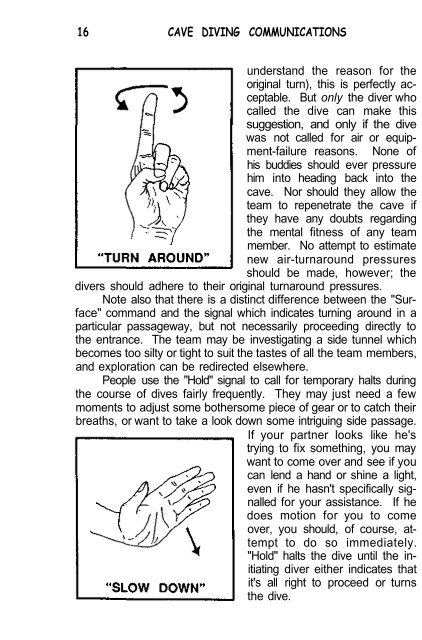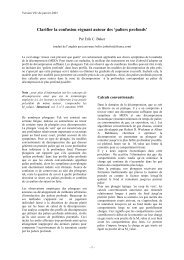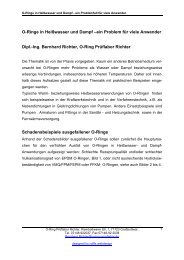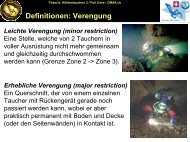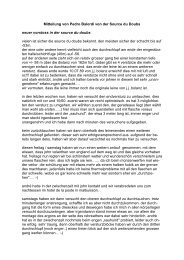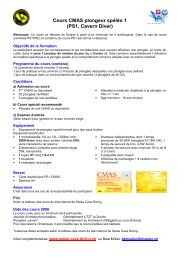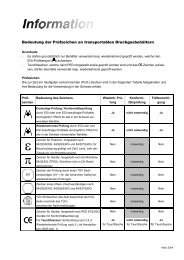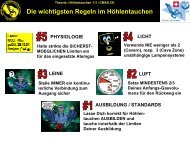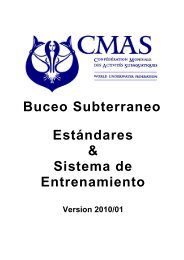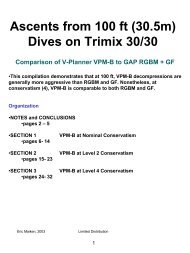cave diving and the nss - bei Swiss-Cave-Diving
cave diving and the nss - bei Swiss-Cave-Diving
cave diving and the nss - bei Swiss-Cave-Diving
Create successful ePaper yourself
Turn your PDF publications into a flip-book with our unique Google optimized e-Paper software.
16 CAVE DIVING COMMUNICATIONS<br />
HAND SIGNALS 17<br />
underst<strong>and</strong> <strong>the</strong> reason for <strong>the</strong><br />
original turn), this is perfectly acceptable.<br />
But only <strong>the</strong> diver who<br />
called <strong>the</strong> dive can make this<br />
suggestion, <strong>and</strong> only if <strong>the</strong> dive<br />
was not called for air or equipment-failure<br />
reasons. None of<br />
his buddies should ever pressure<br />
him into heading back into <strong>the</strong><br />
<strong>cave</strong>. Nor should <strong>the</strong>y allow <strong>the</strong><br />
team to repenetrate <strong>the</strong> <strong>cave</strong> if<br />
<strong>the</strong>y have any doubts regarding<br />
<strong>the</strong> mental fitness of any team<br />
member. No attempt to estimate<br />
new air-turnaround pressures<br />
should be made, however; <strong>the</strong><br />
divers should adhere to <strong>the</strong>ir original turnaround pressures.<br />
Note also that <strong>the</strong>re is a distinct difference between <strong>the</strong> "Surface"<br />
comm<strong>and</strong> <strong>and</strong> <strong>the</strong> signal which indicates turning around in a<br />
particular passageway, but not necessarily proceeding directly to<br />
<strong>the</strong> entrance. The team may be investigating a side tunnel which<br />
becomes too silty or tight to suit <strong>the</strong> tastes of all <strong>the</strong> team members,<br />
<strong>and</strong> exploration can be redirected elsewhere.<br />
People use <strong>the</strong> "Hold" signal to call for temporary halts during<br />
<strong>the</strong> course of dives fairly frequently. They may just need a few<br />
moments to adjust some bo<strong>the</strong>rsome piece of gear or to catch <strong>the</strong>ir<br />
breaths, or want to take a look down some intriguing side passage.<br />
If your partner looks like he's<br />
trying to fix something, you may<br />
want to come over <strong>and</strong> see if you<br />
can lend a h<strong>and</strong> or shine a light,<br />
even if he hasn't specifically signalled<br />
for your assistance. If he<br />
does motion for you to come<br />
over, you should, of course, attempt<br />
to do so immediately.<br />
"Hold" halts <strong>the</strong> dive until <strong>the</strong> initiating<br />
diver ei<strong>the</strong>r indicates that<br />
it's all right to proceed or turns<br />
<strong>the</strong> dive.<br />
If a diver has called a temporary halt in order to catch his<br />
breath, <strong>the</strong> "Hold" sign may very well be followed by a secondary<br />
signal such as "Slow Down." While a "request" such as this does<br />
not have quite <strong>the</strong> absolute authority of "Surface" or "Hold," it is<br />
certainly polite to comply with it if at all possible. Remember, a<br />
diver out of breath is under considerable stress, as well as physiological<br />
insult, <strong>and</strong> this places <strong>the</strong> entire team at greater risk.<br />
Ano<strong>the</strong>r possibility, after <strong>the</strong> initial attention-getting signal, is<br />
that <strong>the</strong> diver may signal some kind of problem, question, warning,<br />
request, suggestion, or observation. Problems such as a line entanglement,<br />
air failure, physical injury, or difficulty with equipment<br />
which <strong>the</strong> diver cannot solve on his own, comm<strong>and</strong> <strong>the</strong> assistance<br />
of <strong>the</strong> buddy. Though <strong>the</strong> problem may not be immediately lifethreatening,<br />
it may quickly upgrade to an urgency, or bona-fide<br />
emergency situation.<br />
Warnings may be urgent or casual <strong>and</strong> concern anything from<br />
treacherous silt; poor silt technique; air leaks, large or small; strong<br />
flow; loose line; dangling equipment posing entanglement hazards<br />
or causing destruction to <strong>the</strong> <strong>cave</strong>; or going <strong>the</strong> wrong way. Warnings<br />
require proper acknowledgment, usually ei<strong>the</strong>r with an "Okay"<br />
sign or repetition of <strong>the</strong> signal followed by an emphatic "Okay" sign<br />
indicating underst<strong>and</strong>ing of <strong>the</strong> serious nature of <strong>the</strong> warning, <strong>and</strong>,<br />
of course, appropriate behavior.<br />
Questions such as "Which way is out?" "How much air do you<br />
have?" "Do you want to go that way?" "What is that?" "What is your<br />
decompression schedule?" or "What is your max depth/bottom<br />
time?" all require some kind of response. If you do not attempt to<br />
"QUESTION" + "WAY TO SURFACE" =<br />
"Which way is <strong>the</strong> way to <strong>the</strong> surface?"


